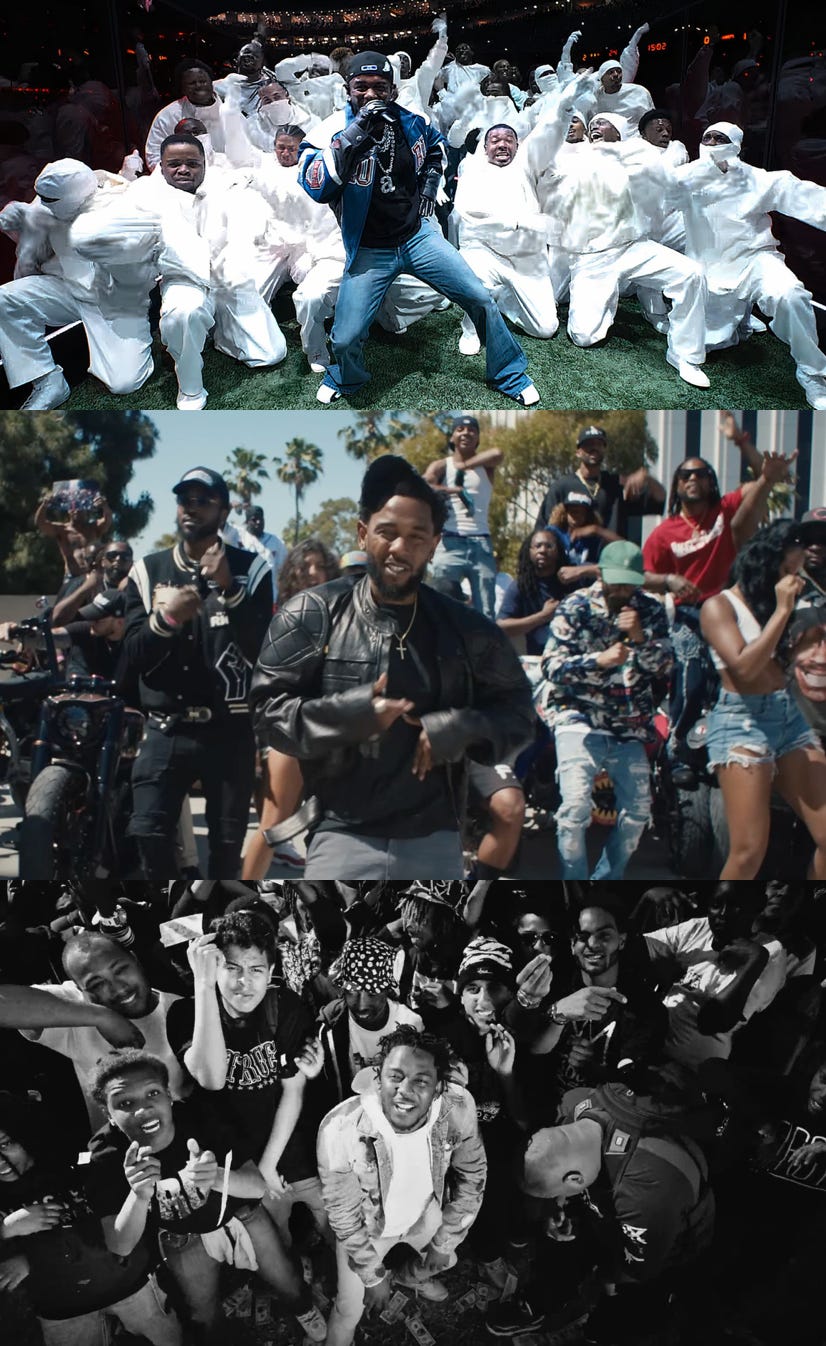“Are you not entertained?” – Maximus Decimus Meridius
From The Coliseum to The Superdome, the one constant thing that has managed to capture our attention for over a millennium is spectacle. In my estimation, there are four key components to spectacle: (i) shock value; (ii) showmanship; (iii) symbolism; and (iv) storytelling.
Using these four elements, we will have a closer look at Kendrick Lamar’s Super Bowl halftime show and see how a thirteen-minute concert instantly became a legacy-defining performance.
I. Shock Value
“He’ll bring them death and they will love him for it.” – Senator Gracchus
Violence, the beating heart of Western civilization. Ever since Cain killed his brother Abel, we have been marked by and drawn to violence. Our most popular forms of entertainment all have some degree of violence: physical violence, emotional violence, lyrical violence.
When Kendrick Lamar was initially invited to perform at the Super Bowl, it was largely because of the way he wielded his particular brand of violence. Not since the early days of Ice Cube had we seen a rapper so thoroughly and viciously dismantle their opponent with one song. A song that inspired as many memes as lawsuits. A song that swept the GRAMMYs and became the number one record in the country for the third time in just over six months.
The big question looming over Kendrick’s halftime show was whether he would perform “Not Like Us”. However, as we will soon see, it’s not enough to simply play the record and expect the crowd to sing along to it.
II. Showmanship
“I wasn’t the best because I killed quickly, I was the best because the crowd loved me.” – Proximo
You can’t just kill your opponent, you have to do it with class. You have to do it with style. You have to take your time with it and make it look sexy. Too short and people will barely notice what is going on. Too long and people will get bored and lose interest.
Think Muhammad Ali and the trash talk he engaged in before his boxing matches. Think Michael Jordan shrugging his shoulders after hitting six three-pointers during Game 1 of the 1992 NBA finals. Think Deion Sanders high-stepping into the end zone and doing the Primetime Shuffle after he scores a touchdown. A moment becomes memorable when there is a bit of magic attached to it.
Whether it was the teasing of “Not Like Us”, the fantastic camera movements in “Peekaboo” or the diabolical smile flashed across our screens during the show’s climax, Kendrick proved himself as the ultimate showman. An emcee who has mastered the art of ceremony and moving the crowd.
III. Symbolism
“It’s an idea…Greatness is a vision.” – Lucilla
It’s one thing to give the people what they want but it’s another thing entirely to give them what they need. Artists come and go but the ones enshrined in history are the ones who stand up for something. How successful they are at doing this depends on the spectator.
Nearly a month later and people are still coming up with theories about Kendrick Lamar’s Super Bowl performance. Some have called it a revolutionary feat of subversion while others have argued that it didn’t go far enough.
For a spectacle to be successful, it has to be something that sticks with you, it has to be something you’re eager to come back to. The bigger the symbol, the grander the spectacle.
Below is a brief breakdown of some visual cues from Kendrick’s halftime show but, for something more thorough and comprehensive, please read Kahlil Greene’s analysis here.




IV. Storytelling
“What we do in life, echoes in eternity.” – Maximus Decimus Meridius
During his Apple Music interview, Kendrick said that the one thing we should expect from his Super Bowl performance was storytelling. Something that has been the backbone of his music and artistry since he changed his stage name with the Kendrick Lamar EP.
For me, Kendrick’s halftime show seems to be in conversation with his 2018 performance at the GRAMMYs. If the latter was a ‘satire’ of the modern Black American experience then the former is a video game walk-through of how to navigate it. Specifically, how to balance the requirements of a mainstream audience with the desire to stay true to yourself and where you came from.
What that left us with was a show filled with contradictions. A show that claimed to ‘televise the revolution’ on a platform driven by capitalism. A show that personified Black excellence for a pastime built on Black bodies. A show that sat its audience down when they previously refused to kneel. A show from the biggest hypocrite and entertainer since 2015: the Compton, California rapper, the gloriously gifted gladiator who goes by the name of Kendrick Lamar.
Further Reading
[1] Ellice Ellis, The Itchiness Of Symbolism, A Few Minutes
[2] J.E.K., Who The Hell Said Kendrick Lamar Was Going To Bring The Revolution?, LiteHouse
[3] Kia Turner, A Meditation For Kendrick, ESSENCE
[4] Zari Taylor, Popular Culture As Propaganda, Bits & Bops
Further Watching
[1] Brandon Shaw, How The Super Bowl Explains Kendrick’s GNX, Digging The Greats
[2] Farah Lawal Harris, Kendrick Lamar’s Super Bowl Halftime Performance Analysis
[3] Josh Johnson, Why Kendrick Lamar’s Super Bowl Halftime Show Is America
[4] Khadija Mbowe, The Revolution Will Be Televised? A Tale Of Two Half-Time Shows
[5] Tom van der Linden, How Gladiator Turns Violent Spectacle Into A Meaningful Story, Like Stories Of Old
[6] Gladiator (2000)
Thank you for reading! Please feel free to like, leave a comment, share this post and / or subscribe for more content down the line.





Thanks for your work and sourcing all this. I dig the Cain an Able reference. Really has me reflecting, on violence and kinship/kingship.
Another great Kendrick essay. Thanks for sharing.♥️